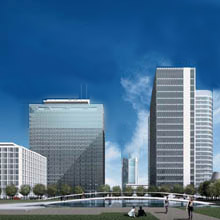
UNESCO recommends constructing the Pankrác high-rise buildings lower
 |
UNESCO recommends that the buildings not exceed 60 to 70 meters, while one of the buildings is supposed to be 104 meters tall. Heritage care in Prague was on the agenda of the UNESCO World Heritage Committee meeting in Canada in July. The report from the meeting is on the UNESCO website; it has not yet been officially released in the Czech Republic, and the Ministry of Culture should receive it in September, which is why they do not wish to comment on it yet. Spokesman Jan Cieslar told ČTK that the heritage department of the Ministry is planning a meeting with the municipality.
"We have not received an official statement from UNESCO, so we do not know its content, and we will not comment on it," said Zuzana Doležalová, spokesperson for the company ECM, to ČTK today. However, if the company had to reduce the building, it would likely complicate the situation. More than a hundred apartments in the taller building already have a buyer; the second building is intended to be a hotel.
At the UNESCO Committee meeting, there were representatives from Prague and the Ministry. When the ministry informed about the meeting in July, it only highlighted praise for Czech heritage care and remained silent about the criticisms related to Pankrác. The UNESCO Committee had already expressed "serious concern" regarding high-rise buildings in the area at its meeting last year. This year, UNESCO's praise concerned the care for those parts of the city that are part of the heritage reserve listed on its list. The proposed high-rise buildings in Pankrác are no longer within the reserve; they would stand in its protective zone, which should visually protect the panorama of Prague.
According to a report from the Czech Republic's permanent representative to UNESCO, Petr Janyška, the committee recommends developing a plan for high-rise construction, which, according to him, does not yet exist, and informing the World Heritage Centre of all projects that could disrupt "visual integrity".
According to Prague councilor Martin Langmajer (ODS), it will be clear within the next eight to 16 months where and how tall buildings can be constructed in the capital. "The basic change was discussed last week by the city council," the councilor said to ČTK.
A year ago, the ministry approved two planned constructions because it supposedly lacked sufficient evidence that the buildings could significantly disrupt the values of the reserve to stop the intention. Although the Ministry was aware that UNESCO criticized the plan to build high-rise buildings, according to ČTK information, this was not sufficient for the officials. A visualization of the Prague skyline with the buildings and a comparable picture from the time before being listed on UNESCO's list could have served as evidence for them, it is claimed. If the ministry had had today's recommendation from UNESCO regarding the height of buildings, it supposedly would have decided differently. However, the committee's opinion could serve as a precedent for the future.
According to Martin Skalský from the Arnika association, which is among the critics of the project, UNESCO's proposal to reduce the buildings corresponds to their opinion. "Today's projects must be rejected, and the construction of Pankrác must be reconsidered from scratch," he stated.
Debates over the two high-rise buildings in Pankrác, which are to complement the three existing ones over 70 meters, have been ongoing since 1999. It is often argued that high buildings already stand in Pankrác. However, opponents of the new ones, including heritage officials, argue that it is primarily about setting precedence and establishing rules for the construction of such buildings near the historical center.
In the case of the two Pankrác buildings, a final verdict regarding heritage care was issued a year ago when the Ministry of Culture confirmed the municipality's decision allowing the buildings. Recently, Prague 4 issued a zoning decision for the construction; after appeals from civic associations, the municipality is now reviewing it, having repeatedly expressed its stance on past constructions.
The English translation is powered by AI tool. Switch to Czech to view the original text source.
0 comments
add comment






